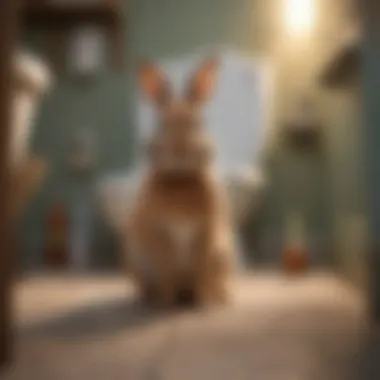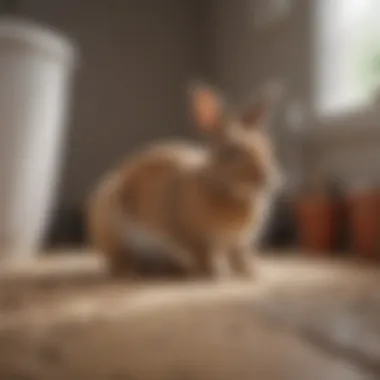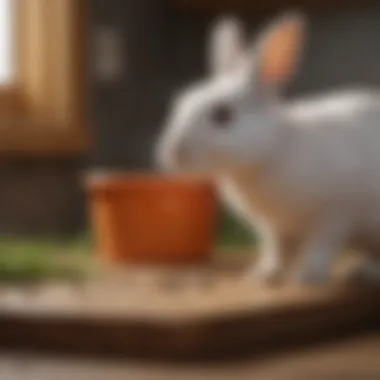Practical Approaches to Potty Training Your Rabbit


Intro
Potty training your rabbit is more than just a simple chore; it’s a journey that fosters a harmonious relationship between you and your furry friend. Many pet owners find that once their rabbit learns where to go, life at home becomes a lot easier. Understanding both the behavior of your pet and the steps involved in training is crucial. This isn't merely an instructional guide; it's an exploration into creating a balanced living environment that works for everyone involved.
In the following sections, we will delve into vital topics such as the nuances of rabbit behavior, tailored care and maintenance, effective training techniques, health considerations, and opportunities for enrichment through activities. By the end, you will have a well-rounded grasp on how to guide your rabbit towards suitable bathroom habits, enhancing not only their comfort but your own as well.
Understanding Rabbit Behavior
Gaining insight into rabbit behavior is crucial for anyone looking to potty train their pet. Relying solely on training methods, without appreciating the natural tendencies of rabbits, can lead to frustrations. Understanding unique habits and instincts of rabbits can inform your approach and make the training process smoother.
The Natural Instincts of Rabbits
Rabbits are creatures of instinct. They tend to keep a clean living space, often choosing specific areas to handle their bathroom needs. This trait comes from their wild ancestors, where scent marking is crucial. A clean environment boosts their safety by reducing the detection chances from predators. Knowing this, pet owners should keep in mind that a pet rabbit will want to make its own designated area, which is essential for successful potty training.
Habits of Wild Rabbits
Wild rabbits have defined habits when it comes to their toilet behavior. They often choose an area away from sleeping and eating spaces. In the wild, a rabbit will use specific spots as latrine sites and return to them consistently. Observing these habits teaches us that rabbits thrive in routines. Mimicking this natural behavior in a home setting not only eases the training process but also aligns the pet's instincts with the owner's expectations. It's pivotal to create an environment that resembles this instinctive behavior.
Observing Your Pet's Routine
Taking time to watch your rabbit at home can yield invaluable information. Rabbits have their own patterns; some may prefer to do their business shortly after waking, while others might wait until they feel secure. Look for signs like circling or sniffing before they go. Jot these observations down. When you identify these key behaviors, you can align your potty training sessions accordingly. Making this connection allows you to tailor the training experience to your rabbit's needs rather than forcing your schedule onto them.
"Understanding how your rabbit behaves can turn what feels like a chore into a well-guided natural process."
Being aware of what drives your rabbit can ease both stress and accidents during training phases. Each rabbit is an individual with unique quirks, and by paying attention to those, pet owners make strides toward successful potty training.
Preparing for Potty Training
Before diving into the actual potty training process for your rabbit, it’s crucial to set the stage right. Preparing effectively makes a world of difference, offering both you and your furry companion an easier journey towards a tidy space. Understanding what tools and environments work best can pave the way for success.
Choosing the Right Litter Box
Selecting a litter box that complements a rabbit’s habits can be the first step to a smooth training experience. As rabbits are not as large as cats, getting a box that’s just the right size is essential. You don't want an oversized fortress or a tiny shoe box—it needs to be in the sweet spot for your rabbit's comfort. Generally, a box with lower sides is preferable, allowing easy access for hopping in and out.
A few litter boxes on the market even come with built-in attachments, affecting the area where urination happens. This could be squeezed into a corner of your home. Think practical; if there’s a spot your rabbit seems to gravitate towards naturally, that could mark your territory.
Selecting Appropriate Litter Material
Types of Safe Litter
When it comes to choosing litter, safety should be your number one priority. Most rabbit owners lean towards options like paper-based pellets, hay, or aspen shavings. Paper-based litter is particularly favored because it’s absorbent and doesn’t have harmful dust particles that could irritate your rabbit’s lungs. A key characteristic of this type is its soft texture; it tends to feel more comfortable for their sensitive paws.
Not only is paper-based litter a good choice due to its safety, but also because it is biodegradable. This means it’s not just good for your rabbit; it’s better for the planet too. Plus, hey, who doesn’t love a two-for-one deal?
Materials to Avoid


While there are options that fit the bill, it’s equally important to know what to steer clear from. Many rabbit owners mistakenly use cedar or pine shavings. Both may smell nice, but they contain oils that can be harmful to a rabbit’s respiratory system in the long run. Using such materials can lead to health issues, from simple irritations to more serious issues like liver damage.
Another common pitfall is cat litter, particularly those with clumping agents. Although they can be convenient, they may pose a choking hazard if ingested and aren’t specially made for rabbits. Avoiding these materials is a no-brainer when preparing for potty training; you want to ensure a healthful environment as a priority.
Creating a Designated Potty Area
Setting up a specific area for your rabbit to do its business gives them a clear signal of where it’s acceptable to relieve themselves. Rabbits thrive on routine, so designating a specific corner—or better yet, a box—will reflect positive habits. Consider placing the litter box in a cozy spot, away from high traffic zones. Surround it with familiar items like some of their favorite toys or a blanket, creating a comfortable oasis that signals safety and security.
Using the aforementioned insights while preparing not only helps in creating a positive atmosphere but also sets you up for success. The groundwork laid here is essential; without it, the training may feel like an uphill battle. So, take that extra step of preparation—it makes training both effective and a lot more enjoyable.
Establishing a Training Routine
Creating a consistent training routine is essential for successful potty training of your rabbit. It's like establishing a rhythm that both you and your furry friend can follow, making it easier to incorporate positive behaviors into daily life. Without a routine, your rabbit may feel confused, and you might find yourself chasing your tail instead of making progress. To ensure a smooth training process, pinpointing specific times for potty training will help in reinforcing those skills effectively.
Identifying Key Training Times
Timing is everything, especially when it comes to potty training a rabbit. Generally, rabbits tend to relieve themselves after eating or waking up from a nap. This pattern can serve as a guide for choosing your training moments. Here are some strategies that can help you identify the best times:
- After Meals: Make sure to observe your rabbit’s eating habits. Once they’ve finished their meal, this is often their cue to head to the litter box. Being patient and offering gently nudges during this period can yield great results.
- Post-Nap: Rabbits, just like humans, need to empty their bladders after a good snooze. If you notice your rabbit is waking from its nap, keep an eye out. A short trip to the designated potty area might be just what they need.
- Playtime Intervals: After engaging in spirited play or exploration, your rabbit may need a break. This can be a perfect time to guide them toward the litter box, reinforcing the connection between positive behavior and appropriate bathroom locations.
By carefully observing your pet's patterns during their day, routines can become apparent. The key is consistency—it’s what helps a rabbit build an understanding of where they should go.
Reinforcing Desired Behavior
Once you've established times for training, reinforcing the behavior becomes paramount. This stage determines whether your rabbit will grasp the routine or if they'll be left in the lurch. Treats and praise can significantly motivate them to use the litter box consistently.
The Role of Treats and Praise
Using treats and praise taps into basic rabbit psychology, which emphasizes positive reinforcement. When you reward your pet right after they use the litter box, you’re instilling a sense of achievement and satisfaction that will encourage them to repeat the behavior.
- Characteristic: One key aspect of treats and praise is the immediate feedback it provides. Rabbits tend to respond well to attention and snacks, which serve to create positive associations with using the litter box.
- Unique Feature: While various types of treats exist, natural options like small pieces of carrot or kale can be great choices, catering to their dietary needs while also standing out from commercial snacks.
- Advantages: This method isn’t just effective; it also enriches the bond you share with your pet. Who wouldn’t enjoy a little treat when they do well? The joy on a rabbit's face, however subtle, is rewarding.
Timing of Reinforcement
Alongside the type of treats, how and when you reinforce behavior is just as crucial. Timing can mean the difference between confusion and understanding for your rabbit.
- Characteristic: The best practice is to provide treats or verbal praise right after they perform the desired action. If you’re delayed, your rabbit may not associate the reward with the potty use.
- Unique Feature: A clicker or verbal cue can add a layer of specificity to your reinforcement. Utilizing a consistent sound or command right as they succeed leads to quicker understanding.
- Advantages: Proper timing not only helps with quicker learning but also reinforces the positive connection between the behavior and the reward, solidifying the overall training process.
Encouraging Consistency
To help solidify the routine, make it consistent across all situations. Routine isn’t just about specific moments; it encompasses daily interactions, environmental conditions, and your response as an owner. When your rabbit sees the same expectations each day, they’re more likely to internalize and retain those litter box habits.
Focusing on these strategies will create a more structured and appreciative environment for you and your rabbit. Establishing routines, timing reinforcements, and insisting on consistency will ensure both of you find success in this training adventure.
Monitoring Progress


Monitoring progress during the potty training journey is essential for ensuring that both you and your rabbit are on the same page. Understanding how your bunny adapts to the training process not only informs you about their habits and preferences but also helps build a stronger bond between the two of you. Just as humans thrive on feedback, rabbits do too. Keeping tabs on their litter box usage can reveal insights that may guide you as you continue with the training.
Understanding Litter Box Usage Trends
Litter box usage trends can provide significant clues about your rabbit's potty habits. Pay close attention to how often your bunny ventures into their box and whether they show specific patterns. For instance, if your pet consistently hops into the box after meals or playtime, it indicates when they are most likely to need relief. This is golden information, as it allows you to anticipate their needs and react accordingly.
Here are some helpful points to consider:
- Frequency of Use: Keep track of how many times your rabbit uses the box in a day. A consistent number can be a good sign that they understand the concept.
- Location Preferences: If your rabbit seems to prefer one spot in their litter box over another, it might be telling you something about their comfort level with certain materials or positioning.
- Time of Day Patterns: Some rabbits may have specific times of day when they are more inclined to use the box. Identifying these times can help reinforce positive habits more effectively.
Recognizing Signs of Setbacks
Just like any training process, there may be hiccups along the way. Setbacks can happen for a variety of reasons, such as changes in environment or stress. Recognizing these signs early can help you address the root causes before they become ingrained habits.
- Sudden Accidents: If your rabbit, who was previously consistently using the box, starts to have accidents, take note. This can indicate stress or a need for adjustment in your routine.
- Defensive Behavior: If your bunny becomes irritable or withdraws, this may be a sign of discomfort or anxiety. It's crucial to observe these behaviors and consider whether your training methods need adjustment.
- Consult Documentation: Keeping notes can be helpful. Write down any changes in your rabbit's behavior regarding their litter habits, along with any changes in their environment or routine. This documentation can help in analyzing trends and potential triggers.
"Observing litter box usage and understanding behavioral shifts is key to ensuring a smooth training process and supporting your rabbit's well-being."
By maintaining a close watch on these elements, you’re not only encouraging positive litter box behaviors but also fostering an environment where your rabbit can feel safe and understood. The goal is to build trust and enhance the overall experience for both you and your furry friend.
Troubleshooting Common Challenges
Potty training a rabbit can often feel like rolling a boulder uphill. Despite the best-laid plans, some hiccups may occur along the way. This section is crucial because addressing these common challenges head-on not only smooths the path for successful training but also reinforces your bond with your furry friend. By understanding the obstacles that may arise, you can assess situations more effectively and adapt strategies quickly to help your rabbit get back on track.
Incomplete Training: What to Do
Sometimes, you may notice that your rabbit isn’t fully grasping the idea of using the litter box. It's not uncommon for pets to have their own ideas about what training means. Assess the situation calmly; consistency is key here. If your rabbit seems confused about where to go, revisit your setup:
- Reinforce the training area: Ensure the litter box is easily accessible and encourages use. A well-placed litter box can do wonders.
- Observe their behaviors: Take note of when your rabbit goes potty. It could be they simply need more time to adjust to the new routine.
- Modify litter types: Sometimes the choice of litter can play a role in their disinterest. Experimenting can lead to the right fit that encourages them to use the box regularly.
Dealing with Accidents
Accidents are part and parcel of the learning experience. Instead of feeling frustrated, take a step back and look at how to tackle this effectively. Understanding the cause behind these accidents can help in minimizing them in the future.
Cleaning Up Effectively
Cleaning effectively is not just about tidying up; it’s about reinforcing good potty habits. If you don't clean correctly, your rabbit might be encouraged to use that spot again, thinking it's now part of their territory.
- Enzymatic cleaners are a game changer. They break down the organic material and eliminate odors that could prompt your rabbit back to the same spot. Just wiping with soap and water won’t do the trick long-term.
- Consistency in cleaning is vital. Make it a point to clean up promptly every time you notice an accident. This reinforces the idea that the litter box is their domain, not an errant corner in your lovely living space.
Avoiding Punishment
Using punishment for accidents may sound tempting, but it doesn’t yield long-lasting results. Imagine how confused your rabbit would feel. They may not understand that it’s about their potty habits rather than their behavior towards you.
- Rewarding positive actions: Shift your focus on rewarding when they successfully use the litter box. It’s much more effective to show appreciation when they do the right thing rather than being punitive about mistakes.
- Building trust is crucial. You wouldn’t want to train your rabbit to fear you during accidents; instead, foster an environment where they feel safe to learn and grow.


Handling Stress and Anxiety
Every rabbit is unique, and some may experience stress or anxiety during potty training, which can disrupt the process. Factors such as loud noises, unfamiliar smells, or even tense interactions within the household can impact their comfort levels. Here are a few things you can do:
- Create a calm atmosphere: Keeping noise to a minimum around their training area can help your rabbit feel more at ease.
- Gentle handling: Make sure to approach your rabbit in a calm manner. Quick movements or loud voices can send them into a panic, making them shy away from the training altogether.
- Routine and predictability: Rabbits thrive on routine. Creating a consistent feeding and cleaning schedule helps them to feel safer and more stable, which can ultimately aid in their potty training.
By addressing these common challenges and troubleshooting effectively, you pave the way for a successful training experience. Rather than letting setbacks discourage you, see them as opportunities to fine-tune your approach and reinforce a positive, trusting relationship with your rabbit.
Long-Term Maintenance of Potty Habits
Maintaining the potty training achievements of your rabbit is just as critical as the initial training process itself. It’s vital for a harmonious home and keeps both the rabbit and owner feeling comfortable. Long-term maintenance ensures the rabbit continues to recognize its designated potty area, thus minimizing accidents around the house. Without consistent upkeep and reinforcement, the behaviors learned can easily be forgotten or dismissed, leading to frustrating situations for both you and your furry friend.
Regular Cleanliness Protocols
A pivotal element in long-term potty training success involves establishing regular cleanliness protocols. Not only does this keep the environment acceptable, but it also reinforces to the rabbit that the designated potty area is the right choice. Here are key points to remember:
- Daily Cleaning: Ensure that you clean the litter box daily. Remove soiled litter and any remaining droppings. This will discourage your rabbit from thinking it can go anywhere else in its living space.
- Deep Cleaning: A deeper clean every week is essential. Washing the box with safe, non-toxic cleaners helps eliminate odors that can confuse the rabbit.
- Replacement Schedule: Change out the litter as needed, ensuring the fresh litter is enough for the rabbit to feel comfortable using it again.
"A clean space encourages good habits. Just like humans, a rabbit prefers a tidy bathroom!"
These cleanliness practices create a reliable environment where the rabbit feels secure in its potty habits. An unkempt area may lead to confusion or anxiety, prompting your rabbit to shy away from its litter box.
Periodic Reinforcement Strategies
Even after your rabbit has mastered using the litter box, periodic reinforcement strategies are vital. Reinforcement not only offers essential acknowledgment to the rabbit but also strengthens its recognition of the litter box as the chosen bathroom space. Here are some effective methods:
- Treats and Praise: Continue offering treats and positive verbal affirmations when the rabbit successfully uses the litter box. This will solidify the association between using the box and receiving something enjoyable. Even a simple "Good job!" can make a world of difference.
- Incorporate Game: Engage your rabbit in playtime near the litter area. This develops a more positive association with the box and the surroundings.
- Adjusting Litter Material: Occasionally changing or mixing litter materials can help keep your rabbit engaged and prevent boredom regarding its bathroom habits.
End
Potty training your rabbit is not just about keeping the house clean; it's about fostering an atmosphere conducive to communication and understanding between you and your furry friend. Successfully teaching your rabbit where to go not only enhances their well-being but also alleviates stress for both pet and owner alike.
Fostering a Positive Living Environment
Creating a pleasant living space is a necessity for both you and your rabbit. A tidy area free from mess promotes good health and encourages your rabbit to feel secure and content. Remember, a rabbit that feels good in their home will naturally gravitate towards the designated potty spot you’ve established.
To ensure this:
- Consistent Cleanliness: Regularly clean the litter box to make it an inviting area for your pet. Rabbits are clean animals and dislike soiling their space. If the box is dirty, they may choose other corners of your home.
- Encourage Exploration: Provide a safe space where your rabbit can roam around. The more they explore, the better they understand where their potty area is.
- Familiar Scents: Using some of their droppings in the litter box can guide them back to the right spot. This works well since rabbits recognize their own scent.
- Positive Reinforcement: Whenever your rabbit uses the litter box correctly, shower them with love and perhaps a small treat to solidify that behavior. They'll quickly learn what pleases you.
Overall, the environment you create not only supports successful potty habits but also enhances your rabbit’s overall happiness.
The Bond Between Owner and Rabbit
The bond between you and your rabbit is crucial for a successful training experience. Successfully potty-training your rabbit can significantly strengthen this relationship. Every completed task towards litter box training serves as a stepping stone in establishing trust and communication.
Effective strategies for bonding during potty training include:
- Gentle Handling: Always handle your rabbit in a calm manner. Unintended stress can fracture the connection you are building with your pet.
- Build Routines: Establishing a daily routine that includes play and feeding times alongside training can solidify trust. Routines are comforting and will also allow your rabbit to prepare for potty time.
- Time together: Spend time lounging or playing with your rabbit outside the potty training scenario. This can enhance their comfort level around you, which is directly beneficial when it comes to training.
- Respect Their Space: Always be patient and give your rabbit space to process what you are teaching them. Forcing interactions can lead to fear or stress and may stall their learning process.
"The key to a strong bond with your pet lies in the understanding and support you provide consistently."
The successful transition to potty habits can linger in the form of a deeper connection, a better understanding of each other's needs, and a home filled with love and humor.







